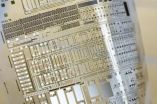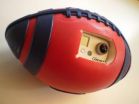(Press-News.org) Millions of tons of food are thrown away each year because the 'best before' date has passed. But this date is always a cautious estimate, which means a lot of still-edible food is thrown away. Wouldn't it be handy if the packaging could 'test' whether the contents are still safe to eat? Researchers at Eindhoven University of Technology, Universitá di Catania, CEA-Liten and STMicroelectronics have invented a circuit that makes this possible: a plastic analog–digital converter. This development brings plastic sensor circuits costing less than one euro cent within reach. Beyond food, these ultra-low-cost plastic circuits have numerous potential uses, including, pharmaceuticals. The invention was presented last week at the ISSCC in San Francisco, the world's most important conference on solid-state circuits.
Consumers and businesses in developed countries throw away around 100 kilograms of food per person (*), mainly because the 'best before' date on the packaging has passed. That waste is bad for consumers' budgets and for the environment. Much of this wastage results from the difficulty in estimating how long food will stay usable. To minimize the risk of selling spoiled food to consumers, producers show a relatively short shelf life on their packaging.
Less than one cent
To fight food waste, producers could include an electronic sensor circuit in their packaging to monitor the acidity level of the food, for example. The sensor circuit could be read with a scanner or with your mobile phone to show the freshness of your steak, or whether your frozen food was defrosted. Researcher Eugenio Cantatore of Eindhoven University of Technology (TU/e): "In principle that's all already possible, using standard silicon ICs. The only problem is they're too expensive. They easily cost ten cents. And that cost is too much for a one euro bag of crisps. We're now developing electronic devices that are made from plastic rather than silicon. The advantage is you can easily include these plastic sensors in plastic packaging." The plastic semiconductor can even be printed on all kinds of flexible surfaces, which makes it cheaper to use. And it makes sensor circuits costing less than one eurocent achievable.
The very first printed ADC
The researchers have succeeded in making two different plastic ADCs (analog-to-digital converters). Each converts analog signals, such as the output value measured by a sensor, into digital form. One of these new devices is the very first printed ADC ever made. "This paves the way toward large area sensors on plastic films in a cost-effective way through printing manufacturing approaches", says Isabelle Chartier, Printed Electronics Business developer at CEA-Liten. The ISSCC rated the papers on these inventions as highlights of the conference.
Missing link
The new plastic ADCs bring applications in the food and pharmaceuticals industries within reach. A sensor circuit consists of four components: the sensor, an amplifier, an ADC to digitize the signal and a radio transmitter that sends the signal to a base station. The plastic ADC has been the missing link; the other three components already exist. "Now that we have all of the pieces, we need the integration," says Cantatore. He expects that it will still take at least five years before we can expect to see the new devices on supermarket shelves. Other potential applications are in pharmaceuticals, man-machine interfaces and in ambient intelligence systems in buildings or in transport.
Complex mathematics
Making this development was no easy task. The electrical characteristics of 'ordinary transistors' are highly predictable, while those of plastic transistors vary greatly. "All plastic transistors behave differently in the low-cost production processes at low temperatures," explains Cantatore. "That makes it much more difficult to use them in devices. You need complex mathematical models to be able to predict their behavior accurately."
The printed ADC circuit offers a resolution of four bits, and has a speed of two hertz. The circuits printed by CEA-Liten include more than 100 n- and p-type transistors and a resistance level on transparent plastic substrates. The carrier mobility of the printed transistors are above the amorphous silicon widely used in the display industry.
INFORMATION:
This development falls under the Cosmic project supported by the EU and the ORICIS project supported by Dutch Technology Foundation STW and the Holst Centre/TNO.
(*) 'Global Food Losses and Food Waste', a study by the Food and Agriculture Organization of the United Nations (FAO), 2011
About Eindhoven University of Technology
Eindhoven University of Technology (TU/e) is a research-driven, design-oriented university of technology with a strong international focus. The university was founded in 1956, and has around 7,200 students and 3000 staff. TU/e has defined strategic areas focusing on the societal challenges in Energy, Health and Smart Mobility. The Brainport Eindhoven region is one of world's smartest; it won the international title Intelligent Community of the Year 2011. Further information on www.tue.nl
About CEA-Liten
CEA-Liten (Laboratory of Innovation for New Energy Technology and Nanomaterials) is an internationally recognized technological research organization part of the CEA's Technological Research Division. Liten aims at developing and transferring technologies to industrial partners. Liten has a staff of 1000 people, an annual budget of 170M€ and an active portfolio of 840 patents. LITEN Printed Electronics activity focuses on large area printing processes development, covering a large range of materials and devices for System On Foil applications: passive devices (R,L,C), sensors (organic photodiodes, pressure, temperature…),organic transistors and logic circuits. CEA PICTIC is the French Printing technology platform dedicated to the ramp-up of printing processes, prototyping and small series production of printed electronics systems for applications in the field of sensors on foils, smart packaging, user interface to accelerate industrial transfer and minimize associated risks. CEA : Commissariat à l'énergie atomique et aux énergies alternatives.
About Universitá di Catania
The University of Catania (UNICT) is a partner of the EU project COSMIC through its "Dipartimento di Ingegneria Elettrica Elettronica e Informatica" (DIEEI). This department has 8 research groups whose activity covers several fields within the area of the information technology, i.e. electrical, electronics, systems, and computer engineering. The research groups are also involving in national and international collaborations with industries and public institutions. Presently, the research staff of the DIEEI includes 55 teaching members.
Within the DIEEI, the Microelectronic Group has a long-standing experience in the field of analog integrated circuits. The group is supported by STMicroelectronics of Catania, Italy, and can take advantage of design and measurement labs, which are well equipped with modern CAD tools and high-performance test instrumentations.
About STMicroelectronics
ST is a global leader in the semiconductor market serving customers across the spectrum of sense and power technologies and multimedia convergence applications. From energy management and savings to trust and data security, from healthcare and wellness to smart consumer devices, in the home, car and office, at work and at play, ST is found everywhere microelectronics make a positive and innovative contribution to people's life. By getting more from technology to get more from life, ST stands for life.augmented. In 2012, the Company's net revenues were $8.49 billion. Further information on ST can be found at www.st.com.
Note for editors (not for publication)
You can read a longer story about this invention on the website of TU/e magazine Cursor: http://www.cursor.tue.nl/en/news-article/artikel/chips-voor-chips/
Attached is a photo which can be used provided that reference is made to the source: Eindhoven University of Technology/Bart van Overbeeke.
Photo caption: The plastic analog-to-digital converter (ADC). The ADC shown is still relatively large, in its final form it will be smaller.
For more information, please contact:
Eindhoven University of Technology:
dr.ir. Eugenio Cantatore
tel. 31-40-247-3388 (office)
You can also contact Science Information Officer ir. Ivo Jongsma
tel. 31-40-247-2110 (office)
31-6-4194-2160 (mobile)
i.l.a.jongsma@tue.nl
Commissariat à l'Energie Atomique:
Vincent Coronini, Press Officer
33-04-38-78-44-30
vincent.coronini@cea.fr
Isabelle Chartier
Printed Electronics laboratory
Business developer
Isabelle.chartier@cea.fr
Romain Coppard, Head of Printed Electronics laboratory
romain.coppard@cea.fr
Universitá di Catania:
Giuseppe Palmisano
39-09-57-38-23-05
giuseppe.palmisano@dieei.unict.it
STMicroelectronics:
Michael Markowitz, Director Technical Media Relations
1-781-591-0354
michael.markowitz@st.com
Invention opens the way to packaging that monitors food freshness
New plastic electronics can greatly reduce food waste worldwide
2013-02-27
ELSE PRESS RELEASES FROM THIS DATE:
Resurrection of 3-billion-year-old antibiotic-resistance proteins
2013-02-27
Scientists are reporting "laboratory resurrections" of several 2-3-billion-year-old proteins that are ancient ancestors of the enzymes that enable today's antibiotic-resistant bacteria to shrug off huge doses of penicillins, cephalosporins and other modern drugs. The achievement, reported in the Journal of the American Chemical Society, opens the door to a scientific "replay" of the evolution of antibiotic resistance with an eye to finding new ways to cope with the problem.
Jose M. Sanchez-Ruiz, Eric A. Gaucher, Valeria A. Risso and colleagues explain that antibiotic ...
Bridging the gap: Hope that all meningitis strains will be vaccinated for
2013-02-27
Scientists at the University of Southampton have taken a significant and important step in keeping people safe from the most common form of meningitis in the UK.
Meningitis B (also known as Meningococcal group B or MenB) is one of the deadliest strains of meningitis. Each year, an average of 1,870 people in the UK are affected by the disease with one in 10 people dying from it.
Recently the first potentially universal MenB vaccine was awarded a license for use throughout Europe, but it has been estimated that in this country, this new vaccine should protect against ...
Camera inside spiraling football provides ball's-eye view of field
2013-02-27
PITTSBURGH—Football fans have become accustomed to viewing televised games from a dozen or more camera angles, but researchers at Carnegie Mellon University and the University of Electro-Communications (UEC) in Tokyo suggest another possible camera position: inside the ball itself.
The researchers have shown that a camera embedded in the side of a rubber-sheathed plastic foam football can record video while the ball is in flight that could give spectators a unique, ball's-eye view of the playing field. Because a football can spin at 600 rpm, the raw video is an unwatchable ...
A new anti-frost and anti-fog coating for glass
2013-02-27
In an advance toward glass that remains clear under the harshest of conditions, scientists are reporting development of a new water-repellant coating that resists both fogging and frosting. Their research on the coating, which could have uses ranging from automobile windshields to camera lenses, appears in the journal ACS Nano.
Michael F. Rubner, Robert E. Cohen and colleagues point out that anti-fogging coatings that absorb water have been the focus of attention lately because of their ability to reduce light scattering and the resultant distortion caused by condensation. ...
2 new species of mushroom on Iberian Peninsula described
2013-02-27
This press release is available in Spanish.
In a study published in the Mycologia journal, researchers from the Basque Country, in collaboration with the Spanish Royal Botanic Garden and the Forestry Institute of Slovenia, have described two new species of Hydnum – colloquially known as Wood Hedgehog or Hedgehog mushroom. Mushrooms of the Hydnum genus are well known because many of them are edible.
"In the work we describe two new species: Hydnum ovoideisporum and Hydnum vesterholtii, which belong to a genus colloquially called 'Hedgehog mushrooms'. Although many ...
Pessimism about the future may lead to longer, healthier life, research finds
2013-02-27
WASHINGTON – Older people who have low expectations for a satisfying future may be more likely to live longer, healthier lives than those who see brighter days ahead, according to new research published by the American Psychological Association.
"Our findings revealed that being overly optimistic in predicting a better future was associated with a greater risk of disability and death within the following decade," said lead author Frieder R. Lang, PhD, of the University of Erlangen-Nuremberg in Germany. "Pessimism about the future may encourage people to live more carefully, ...
Estimates reduce amount of additional land available for biofuel production
2013-02-27
Amid efforts to expand production of biofuels, scientists are reporting new estimates that downgrade the amount of additional land available for growing fuel crops by almost 80 percent. Their report appears in the ACS journal Environmental Science & Technology.
Steffen Fritz and colleagues explain that growing concern exists in the U.S. and the European Union on how production of biofuels will impact food security. This has led to a realization that increased production of biofuels must take place on so-called "marginal land," acreage not suitable for growing food crops, ...
Seeing through HIV's disguises
2013-02-27
Studying HIV-1, the most common and infectious HIV subtype, Johns Hopkins scientists have identified 25 human proteins "stolen" by the virus that may be critical to its ability to infect new cells. HIV-1 viruses capture many human proteins from the cells they infect but the researchers believe these 25 proteins may be particularly important because they are found in HIV-1 viruses coming from two very different types of infected cells. A report on the discovery, published online in the Journal of Proteome Research on Feb. 22, could help in building diagnostic tools and novel ...
Too much vitamin D during pregnancy can cause food allergies
2013-02-27
This press release is available in German.
Leipzig/Halle. Pregnant women should avoid taking vitamin D supplements. Substitution appears to raise the risk of children developing a food allergy after birth. This was the conclusion drawn from a new survey carried out by the Helmholtz Centre for Environmental Research and the Martin Luther University in Halle-Wittenberg in Germany which was published in the February issue of the medical journal Allergy.
Vitamin D has always had a good reputation: it strengthens bones, protects against infections particularly during the ...
Promising breakthrough for transplant patients
2013-02-27
This press release is available in French.
A team led by Dr. Marie-Josée Hébert from the University of Montreal Hospital* Research Centre (CRCHUM) has discovered a new cause of organ rejection in some kidney transplant patients. Her team has identified a new class of antibodies – anti-LG3 – which when activated lead to severe rejection episodes associated with a high rate of organ loss. This discovery, which holds promise for organ recipients, was published in the online version of the American Journal of Transplantation.
Rejection is one of the major obstacles to organ ...
LAST 30 PRESS RELEASES:
Making lighter work of calculating fluid and heat flow
Normalizing blood sugar can halve heart attack risk
Lowering blood sugar cuts heart attack risk in people with prediabetes
Study links genetic variants to risk of blinding eye disease in premature infants
Non-opioid ‘pain sponge’ therapy halts cartilage degeneration and relieves chronic pain
AI can pick up cultural values by mimicking how kids learn
China’s ecological redlines offer fast track to 30 x 30 global conservation goal
Invisible indoor threats: emerging household contaminants and their growing risks to human health
Adding antibody treatment to chemo boosts outcomes for children with rare cancer
Germline pathogenic variants among women without a history of breast cancer
Tanning beds triple melanoma risk, potentially causing broad DNA damage
Unique bond identified as key to viral infection speed
Indoor tanning makes youthful skin much older on a genetic level
Mouse model sheds new light on the causes and potential solutions to human GI problems linked to muscular dystrophy
The Journal of Nuclear Medicine ahead-of-print tip sheet: December 12, 2025
Smarter tools for peering into the microscopic world
Applications open for funding to conduct research in the Kinsey Institute archives
Global measure underestimates the severity of food insecurity
Child survivors of critical illness are missing out on timely follow up care
Risk-based vs annual breast cancer screening / the WISDOM randomized clinical trial
University of Toronto launches Electric Vehicle Innovation Ontario to accelerate advanced EV technologies and build Canada’s innovation advantage
Early relapse predicts poor outcomes in aggressive blood cancer
American College of Lifestyle Medicine applauds two CMS models aligned with lifestyle medicine practice and reimbursement
Clinical trial finds cannabis use not a barrier to quitting nicotine vaping
Supplemental nutrition assistance program policies and food insecurity
Switching immune cells to “night mode” could limit damage after a heart attack, study suggests
URI-based Global RIghts Project report spotlights continued troubling trends in worldwide inhumane treatment
Neutrophils are less aggressive at night, explaining why nighttime heart attacks cause less damage than daytime events
Menopausal hormone therapy may not pose breast cancer risk for women with BRCA mutations
Mobile health tool may improve quality of life for adolescent and young adult breast cancer survivors
[Press-News.org] Invention opens the way to packaging that monitors food freshnessNew plastic electronics can greatly reduce food waste worldwide




